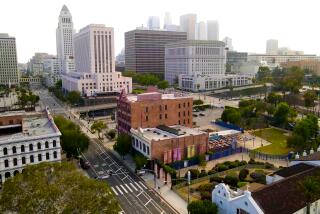Indians Gather for Reburial Ritual on Site Where Hall Was to Have Risen
- Share via
The dump truck backed up to the edge of the pitted lot, just a few feet away from the neat square holes dug by archeologists this spring. From a distance, Msgr. I. Brent Eagen watched the truck disgorge another load of earth, one of the 30 such loads it carried Friday up to Mission San Diego de Alcala.
The earth will soon cover caisson holes originally dug for the parish hall that was to be built on the site. The human remains and mission ruins whose discovery ultimately scuttled the project will be buried beneath it.
Eagen’s signature Thursday on an agreement with local Indians scrapped his decade-old plans for the site. On Friday, Kumeyaay Indians hastily prepared for a reburial ceremony that will consecrate part of the lot as an Indian cemetery.
Indians Arrive at Mission
Descendants of Mission Indians from all over San Diego County have been asked to take part in a burial ritual that began Friday and was to continue all night and into this morning, said Kumeyaay leader Ron Christman. Kumeyaay Indians began arriving at the mission Friday morning to help put up cooking tents and the traditional ramada-- a temporary structure over the graves that symbolizes a church.
Eagen, until recently accused by the Kumeyaay of gross disrespect for their dead, said he will conduct Catholic services to complement the Indian ceremony as called for in the agreement between the diocese and Indian representatives.
The detailed document also specifies when the Indians may hold the services, how long they may stay, the height of the wooden cross the Indians plan to erect in the cemetery, and the type of soil the mission must supply to the Indians.
The pact “demonstrates our commitment to our friends in the Indian community and our sensitivity to their concerns,” Eagen said in a press release. “We pray that today’s agreement will remind all of us how much we mean to one another.”
Although the agreement deals largely with the eastern one-third of the site designated as an Indian cemetery, ruins and bones on the rest of the site will be buried and sodded as well, Eagen said Friday. Preserving the exposed ruins as an exhibit would place too much of a burden on the mission and parish, he said.
That plan drew an immediate protest from City Councilwoman Judy McCarty, an outspoken preservationist. “I hope that (the diocese) will one day come to realize the site’s significance,” McCarty said. “I was very hopeful that the area could be preserved.”
McCarty acknowledged that the mission can legally proceed with its plans, but said she hopes a public hearing Monday before the City Council will show the site’s importance. “We owe it to the people of San Diego to put the facts on the record,” she said.
Differing With Preservationists
Although the mission has settled its dispute with the Indians, it still differs with historical preservationists on their proper role in mission planning.
The preservationists have called for a new master plan for the mission, one developed in concert with preservation experts. “The mission has to come into 1989 and acknowledge that it is necessary to include outside interests” in the planning process, said preservationist activist Joy Massa.
But mission spokesman William Finley disagreed. “Certainly, we are now more aware of outside concerns,” he said. “But the bottom line is that the church is still the landowner here.”
Eagen said the mission drew up its own master plan in the 1970s and does not need a new one.
The issue could resurface when or if the diocese finds a new site for the meeting hall project. On Friday, Eagen identified a recently purchased 3 acres immediately north of the mission compound as the primary alternative site. He said a site should be selected by October.
More to Read
Sign up for Essential California
The most important California stories and recommendations in your inbox every morning.
You may occasionally receive promotional content from the Los Angeles Times.













